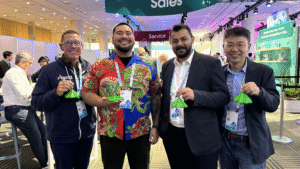AI has sparked conversations across boardrooms. According to a report published by Thomson Reuters, 62 percent of C-suite executives are exploring the potential for and implementing AI. However, the majority of these industry leaders struggle to move beyond discussion and into decisive action. The slow adoption of AI stems not from a lack of will but from limited knowledge or experience. In a Deloitte survey published in August, 66 percent of respondents expressed their limited expertise in AI.
The chasm between expectation and execution could be narrowed with partners who can translate executive vision into measurable results. Almost all C-suite executives understand and appreciate the importance of AI in today’s world, but feel they are underprepared to efficiently implement it. They are asking what the gap is and how to fill it, and that is where Gruve steps in.
Gruve builds AI Workflows and AI-human Teams across core operations to drive real business growth while ensuring adoption with industry-specific knowledge and compliance. It creates workflows and hybrid team structures where human expertise and AI complement each other to deliver real outcomes.
This blog discusses expectations from AI and how Gruve turns board-level AI conversations into tangible and verifiable results.
Reimagining the Workforce: The Dawn of AI and Human Collaboration
AI alongside humans
AI has progressed from being a hypothetical concept to a workforce multiplier. Ironically, the advent of agentic AI as a complementary force has been met with skepticism, primarily from technical teams, while marketing teams across industries have embraced it. Technical teams are hesitant to adopt agentic AI due to concerns over security risks, unpredictability, accountability, and even the risk of job displacement to autonomous AI. However, autonomous AI is not a threat; rather, it is an opportunity waiting to be fully realized. The security and compliance risks primarily stem from using subpar data for training AI modules.
These risks can be mitigated with Gruve’s help. Gruve builds an AI-ready data foundation that enables enterprises to generate and measure business outcomes from AI use cases. Furthermore, Gruve ensures that it meets four crucial parameters for building a future-proof AI-ready data foundation. These parameters are (1) Trust (quality and fitness); (2) Control (secure access and governance); (3) Compliance (policy and legal alignment); and (4) Validation (provenance and ongoing tests).
Today, it is crucial for human employees to work alongside AI counterpart, increasing productivity, efficiency, and cost-effectiveness. The rapid development in AI capacity underscores the need for a hybrid team model, which essentially means not replacing humans with autonomous AI, but rather yoking human judgment with AI execution for faster and more efficient results. According to a Clanx report published on January 31, 2024, 72 percent of businesses using AI report higher productivity.
The efficiency and effectiveness brought about by AI will lead to the restructuring of the workforce in the coming times, building agility and scale into business operations.
Flattening the workforce and re-balancing power
The question is not if but when there will be some flattening of the workforce. Sooner rather than later, we will witness a rebalancing of power between talent and management. It means employees will wield AI-enabled tools and may require different reporting or leadership models. And this is where Gruve comes into the picture. It builds AI-enabled Teams to take on tedious tasks across core business functions such as marketing, sales, accounting, HR, security, engineering, and operations, reorienting the workforce and eliminating inefficiencies from the process.
How does this change hiring and leadership?
AI is reimagining the hierarchical arrangement of the workforce. The top-down command is gradually shifting towards the orchestration of human-AI teams. According to a recent Deloitte survey, 61 percent of surveyed workers believe AI can play a crucial role in upskilling opportunities for the entry-level workforce, while another 61 percent believe that AI will help experienced professionals in sharing their knowledge with others.
In a world disrupted by advances in AI, it is important for organisations to adapt to changing market requirements and expectations. Leaders ought to think about how they can attract, develop, and retain people who can operate and thrive in a hybrid environment.
The lightning speed with which AI has reimagined organizations globally has taken many by surprise. However, the feeling of being overwhelmed does not stem from AI itself, but rather from a lack of understanding about how AI works and how it can be co-opted in everyday business operations for better, faster results.
Gruve’s Hybrid Teams and AI Workflows
What Gruve does
Gruve helps enterprise companies at the board level understand AI’s value and impact. It builds AI-enabled teams across various functions, including marketing, sales, HR, engineering, and operations. It also designs workflows that combine human expertise and AI to complement each other, tailored for specific industries.
The workflow concept
A workflow for an AI-human hybrid team is a structured process in which:
- AI handles routine, high-volume, rule-based tasks
- Humans provide judgment, domain knowledge, and exception handling
- Data governance, training, and adaptation mechanisms ensure ongoing performance
Gruve emphasises that organisations move beyond pilots to “real business growth and cost reduction”.
Outcome-based focus
Gruve does not charge for technology alone. It charges based on outcomes or teammate count, signaling a shift toward value realization rather than experimentation. It is worth noting that Gruve’s team model is only possible with the right data foundation.
Let’s find out how Gruve builds that foundation.
Building the AI-Ready Data Foundation
Before building an AI-ready data foundation, it is essential to define what constitutes AI-ready data.
Defining AI-ready data
Gruve defines an “AI-ready data foundation” through four parameters: Trust (quality/fitness); (2) Control (secure access/governance); (3) Compliance (policy/legal alignment); (4) Validation (provenance and ongoing tests).
Why it matters
According to several studies, only 28 percent of enterprises consider themselves advanced in data readiness for AI. Poor data foundations delay or derail AI outcomes. The Cisco AI Readiness Index highlights that 99 percent of pacesetters have a well-defined AI strategy, vis-à-vis 58 percent overall. In short, organizations cannot execute what they have not planned for.
Leading AI in the Workplace: Roles, Culture, and Strategy
Executive and board buy-in
To make AI readiness a reality, organizations need to start at the top. AI readiness demands board-level involvement and C-suite buy-in, including chief executives and corporate leaders. Research shows that firms with strong C-suite alignment on AI outperform peers.
Culture, skills, and resistance
Even when tools are available, workforce anxiety or skill gaps can block progress. According to a report published by Deloitte on August 25, 2025, only 42 percent of older tenure workers feel prepared to use AI, compared to 66 percent of younger ones who are proficient in using AI. Organizations must therefore deliver training and embed human-AI fluency.
New value proposition for workers
Human roles are shifting more toward analysis, judgment, and strategic thinking, thanks to AI taking over routine tasks. Deloitte’s 2025 Human Capital Trends indicate a move from productivity measurement to human performance underpinned by AI. Leaders must articulate a future in which human and AI collaboration creates new career paths, not just cost cuts .
Conclusion
AI is reimagining the workplace. It demands not just tools but also a new approach to workflows, re-skilled teams, and leadership that understands both technology and human dynamics. Gruve’s approach—building AI-human hybrid teams and a robust AI-ready data foundation—offers a roadmap for enterprise transformation. Organisations that adopt this blueprint can move from pilot to performance, from promise to realised business growth. More importantly, they can change what work is, how talent contributes, and how leadership steers the future. They will achieve this not simply by automating tasks but by amplifying human potential in concert with AI.
Let’s Talk







